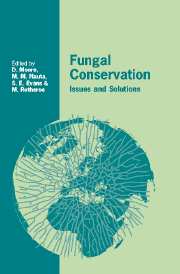Book contents
- Frontmatter
- Contents
- List of contributors
- Preface
- 1 Fungal conservation issues: recognising the problem, finding solutions
- 2 Current trends and perspectives for the global conservation of fungi
- 3 Conservation and management of forest fungi in the Pacific Northwestern United States: an integrated ecosystem approach
- 4 The future of fungi in Europe: threats, conservation and management
- 5 Fungi as indicators of primeval and old-growth forests deserving protection
- 6 Recognising and managing mycologically valuable sites in The Netherlands
- 7 Threats to hypogeous fungi
- 8 Wild mushrooms and rural economies
- 9 Threats to biodiversity caused by traditional mushroom cultivation technology in China
- 10 A preliminary survey of waxcap grassland indicator species in South Wales
- 11 Grasslands in the coastal dunes: the effect of nature management on the mycota
- 12 The conservation of fungi on reserves managed by the Royal Society for the Protection of Birds (RSPB)
- 13 Strategies for conservation of fungi in the Madonie Park, North Sicily
- 14 Fungal conservation in Ukraine
- 15 The threatened and near-threatened Aphyllophorales of Finland
- 16 Fungal conservation in Cuba
- 17 Microfungus diversity and the conservation agenda in Kenya
- 18 Fungi and the UK Biodiversity Action Plan: the process explained
- 19 The Scottish Wild Mushroom Forum
- 20 The contribution of national mycological societies: establishing a British Mycological Society policy
- 21 The contribution of national mycological societies: the Dutch Mycological Society and its Committee for Fungi and Nature Conservation
- 22 Fungal conservation in the 21st century: optimism and pessimism for the future
- Index
12 - The conservation of fungi on reserves managed by the Royal Society for the Protection of Birds (RSPB)
Published online by Cambridge University Press: 13 October 2009
- Frontmatter
- Contents
- List of contributors
- Preface
- 1 Fungal conservation issues: recognising the problem, finding solutions
- 2 Current trends and perspectives for the global conservation of fungi
- 3 Conservation and management of forest fungi in the Pacific Northwestern United States: an integrated ecosystem approach
- 4 The future of fungi in Europe: threats, conservation and management
- 5 Fungi as indicators of primeval and old-growth forests deserving protection
- 6 Recognising and managing mycologically valuable sites in The Netherlands
- 7 Threats to hypogeous fungi
- 8 Wild mushrooms and rural economies
- 9 Threats to biodiversity caused by traditional mushroom cultivation technology in China
- 10 A preliminary survey of waxcap grassland indicator species in South Wales
- 11 Grasslands in the coastal dunes: the effect of nature management on the mycota
- 12 The conservation of fungi on reserves managed by the Royal Society for the Protection of Birds (RSPB)
- 13 Strategies for conservation of fungi in the Madonie Park, North Sicily
- 14 Fungal conservation in Ukraine
- 15 The threatened and near-threatened Aphyllophorales of Finland
- 16 Fungal conservation in Cuba
- 17 Microfungus diversity and the conservation agenda in Kenya
- 18 Fungi and the UK Biodiversity Action Plan: the process explained
- 19 The Scottish Wild Mushroom Forum
- 20 The contribution of national mycological societies: establishing a British Mycological Society policy
- 21 The contribution of national mycological societies: the Dutch Mycological Society and its Committee for Fungi and Nature Conservation
- 22 Fungal conservation in the 21st century: optimism and pessimism for the future
- Index
Summary
Introduction
The Royal Society for the Protection of Birds (RSPB) is the largest wildlife conservation charity in Europe with over one million members. It manages over 150 nature reserves throughout the UK, covering more than 108 000 hectares. Away from the reserves the Society safeguards sites and species of conservation importance through research, lobbying and education, whilst outside the UK the RSPB is working with Birdlife International Partners on major conservation projects in 18 countries in Europe, Africa and Asia. The RSPB, together with voluntary organisations, has produced a practical guide to conserving the UK's biodiversity that has been adopted at Government level.
The Society is committed to the management of nonavian taxa on its reserves, and is UK champion for nonbird species such as the medicinal leech, Hirudo medicinalis. The Society's interest in other biotic groups has been somewhat biased towards invertebrates and lower plants, for the most part to the exclusion of the fungi. This latter fact is understandable given the difficulties with identification and the complex taxonomy within mycology. In recent years an interest in the fungi on RSPB reserves has been encouraged by one or two active field mycologists, and has gradually led to the development of an in-house strategy for their conservation.
Threatened in Europe
A rapid decline of fungi across northern Europe has been reported since the 1980s. Before discussing habitats and species on RSPB reserves the European situation needs to be understood.
- Type
- Chapter
- Information
- Fungal ConservationIssues and Solutions, pp. 144 - 155Publisher: Cambridge University PressPrint publication year: 2001
- 1
- Cited by



